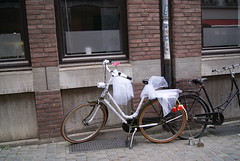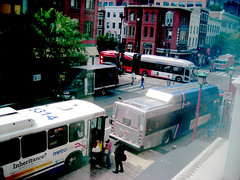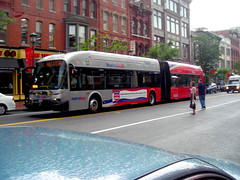|
Special Features





Image Libraries


|
|
Blog
I’m getting married in a week and a half.
Between now and then, I’ve got to get ready for the wedding, wrap up business at work, and help my fiance prepare her booth at this Saturday’s gigantic Crafty Bastards Arts & Crafts Fair (drop by for some awesome urbanist-themed paper goods).
After the wedding there’s our honeymoon to the Pacific Northwest, which we’re putting off a few days so I can attend Rail~Volution. Yes, I’m a lucky guy to have found a girl who will literally put off our honeymoon so I can geek out to transit.
Needless to say, I’m busy. There just aren’t enough hours in the day to blog much. And so, don’t expect many posts on BeyondDC for the next month. You’ll still be able to find me on Twitter, where I’ll live-tweet Rail~Volution and send greetings from Portland’s streetcar, but here on the main blog it’s going to get lonely.
Cheers, and have a good month.
Average Rating: 4.5 out of 5 based on 226 user reviews.
September 29th, 2011 | Permalink
Tags: site

Traditional architecture and modern architecture have different strengths and weaknesses.
Traditional architecture, with its focus on ornament and human-scaled components, provides the most visually stimulating sidewalk presence. That makes traditional architecture more pedestrian friendly and thus, from an urban design standpoint, superior.
On the other hand, modern architecture has its own set of strengths. Its focus on treating buildings as sculptures to be appreciated from afar as singular artistic statements is ideally suited for skyscrapers.
And so I have always wanted to see an architecture that combined the two, to provide sculpturally beautiful skyscrapers with ornamented, human-scaled bases.
The building pictured at right does exactly that. It is located in New Westminster, British Columbia, and is an experiment in hybridization. The building isn’t perfect; the materials and level of ornament on the traditional base aren’t quite right, for example. Regardless, it is a fascinating experiment, and a style I’d like to see used more often.
Average Rating: 4.4 out of 5 based on 252 user reviews.
September 27th, 2011 | Permalink
Tags: architecture

All these Capital Bikeshare expansions are getting confusing. BeyondDC discussed expansion earlier this week, but that post is already obsolete since DDOT’s Wednesday announcement that it is funding 50 new stations in addition to the 30-some already under way.
Let’s take this opportunity to record the history and near future of expansion, in a nice clear table.
I’ll try to update this list whenever new information becomes available, and will add a link to it in the “Features” menu on the BeyondDC home page (left side of the screen) so it always easy to find.
| Location |
Stations |
Date |
Official Link |
| Original System |
| Arlington – Crystal City |
14 |
Sept 2010 |
|
| DC |
100 |
Sept 2010 – Feb 2011 |
|
| Completed Expansions |
| Arlington – Rosslyn |
4 |
April 2011 |
|
| Funded Future Expansions |
| DC – first expansion |
34* |
Fall 2011 |
Link |
| Arlington – Rosslyn-Ballston corridor |
33* |
Late 2011 |
Link |
| DC – second expansion |
50 |
Early 2012 |
Link |
| Rockville |
20 |
Sometime 2012 |
Link |
| Alexandria |
6** |
Sometime 2012 |
N/a |
| Total Funded System |
| Regional |
261 |
2012 |
|
* The DC and Arlington 2011 expansions have generally been reported as being “around 25 and 30 stations” respectively. I came up with 34 and 33 stations by counting the proposed locations shown on the linked maps.
** Apparently Alexandria’s participation is still somewhat up in the air. They have tentatively funded 6 stations, but may still move the funding elsewhere.
Average Rating: 4.6 out of 5 based on 185 user reviews.
September 23rd, 2011 | Permalink
Tags: bike, featured post, transportation

|
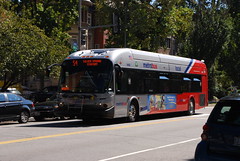
An S4 Metrobus. An S2 is undoubtedly close. |
One of the key advantages of DC Circulator buses over WMATA Metrobuses is how they are scheduled. WMATA will soon adopt a more Circulator-like approach for one of its busiest routes.
Circulator buses don’t have a traditional schedule, they simply try to keep about 10 minutes apart from each other, so that riders never have to wait long for a bus. WMATA buses, on the other hand, try to keep to a timetable, which is often impossible and which inevitably leads to “bus bunching, ” in which multiple buses come at the same time and leave large gaps between them.
As a frequent rider of the S-series Metrobuses on 16th Street, I can say with authority that bus bunching is the rule there, rather than the exception. It’s incredibly frustrating to wait 25 minutes for a bus that is supposed to come every few minutes, and then to have 3 buses roll by all in a row. Incredibly frustrating. And it happens all the time.
The good news – the fantastic news – is that with Circulator’s successful example out there proving how timetable-less, headway-based scheduling can work, WMATA is now willing to make its own experiment with the idea. They will first implement headway scheduling on the 90s series bus routes. Rather than futilely hoping to stick on a timetable, this weekend 90s-series buses will begin to try and remain 7 to 8 minutes away from other 90s-series buses.
I’m sure the experiment will prove successful, and hope WMATA quickly shifts to headway scheduling on other high-frequency bus lines, such as 16th Street, 14th Street, and Georgia Avenue.
Average Rating: 4.7 out of 5 based on 152 user reviews.
September 22nd, 2011 | Permalink
Tags: bus, transportation

Yesterday was the one year anniversary of the launch of Capital Bikeshare, America’s largest experiment in public bikesharing to date. The anniversary offers a good opportunity to quickly look back on the program’s successes and failures, and to look forward at what’s to come.
So how did the first year go? Pretty darn well. The system has over 18, 000 registered members, which puts its members-per-bikes ratio in very elite company globally. It has logged over a million trips, which is double the estimate for its first year. The bikes are ubiquitous in the central city, and are well on their way to icon status. That’s the good news.
The bad news is that the anticipated problem of station sparsity has indeed been an issue. Dock blocking is common enough that the term has entered the lexicon of Washingtonians. The most successful bikesharing systems offer stations closely packed enough so that dock blocking isn’t a big concern.
So in a very real way, Capital Bikeshare’s biggest problem is that too many people are using it. It’s a good problem to have.
And so, with a successful first year under its belt, Cabi is looking to expand. Four expansions are currently funded and anticipated to come online within the next year. Together they will enlarge the system from its current level of 116 stations located in two jurisdictions, up to around 200 stations in four jurisdictions. And no one expects expansion to stop there. All the existing member jurisdictions are considering even more stations, and other jurisdictions may still join the network.
What will that new, larger system look like? Here is a map showing the 116 existing stations (circles), plus the approximate planned locations of the 60 or so in DC and Arlington that are funded and will come online at various times in the coming months (squares). Additional stations are funded in Shady Grove and Alexandria, but location information is not available yet.
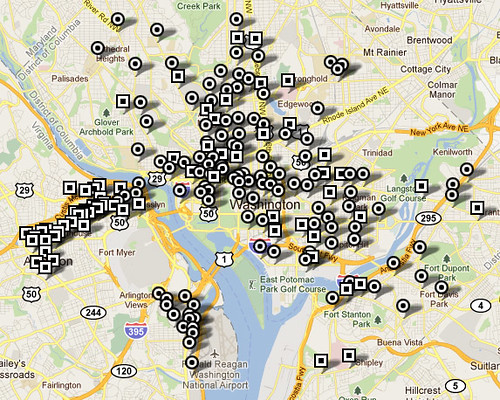
Click the map for interactive version.
Average Rating: 4.4 out of 5 based on 205 user reviews.
September 21st, 2011 | Permalink
Tags: bike, transportation

Ever wonder what’s on the inside of the electronic billboards that are integrated into downtown bus shelters?
No? Me neither.
But I got a glimpse one night last week, so why not share. Someone was performing maintenance while I was waiting for a bus.
Pardon the cell phone camera image. You can click the picture to enlarge it and get more detail, but it’s grainy. |
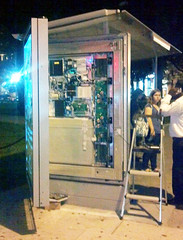 |
Average Rating: 4.6 out of 5 based on 205 user reviews.
September 19th, 2011 | Permalink
Tags: Did you ever wonder, fun

What the… I don’t even…

Yes, that’s a car in the subway. No, I don’t know where it’s from or if it’s real.
Average Rating: 4.8 out of 5 based on 164 user reviews.
September 16th, 2011 | Permalink
Tags: fun, metrorail, roads/cars, transportation

|
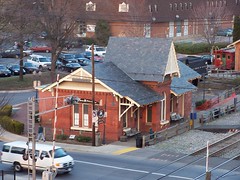
Gaithersburg can’t develop the area around its train station because of a misguided school capacity ordinance. |
A few years ago Gaithersburg adopted an ordinance to ensure that infrastructure keeps up with growth. It seemed like a good idea at the time. Unfortunately, the law turned out to be counterproductive, as it damaged the city’s ability to grow in the right places.
Gaithersburg has a big problem. On one hand, the city is trying very hard to promote smart growth. They’ve adopted beautiful master plans, and worked with developers to design some very strong projects. On the other hand, they have a crippling adequate public facilities ordinance that slaps a complete moratorium on residential development in large swaths of the city.
The city’s two hands are pulling in opposite directions. Mountains of genuinely good planning effort supports smart growth, but this one ordinance requiring excess school capacity throws a wrench into the whole business.
It’s especially maddening because of the way school boundaries are drawn. The most overcrowded schools happen to also cover most of Gaithersburg’s smart growth receiving areas, including its most walkable and transit-connected downtown and new urbanist districts. For the most part it isn’t the smart growth developments that are overcrowding the schools (they tend to attract smaller families), but because they’re within the same school boundary as other neighborhoods that do produce a lot of kids, residential development is outlawed in precisely the areas where it’s most appropriate.
And the really bad news is that the moratorium isn’t effective at saving schools. Because Gaitheresburg is a geographically small jurisdiction within a larger, growing region, the school capacity test merely pushes growth out to other jurisdictions that have even less capacity, and less ability to plan. In fact, the moratorium is doubly damaging because of the type of growth it is pushing away. By including these smart growth receiving zones in the moratorium, Gaithersburg is pushing out high density urban developments that don’t produce many students, but are very effective at reducing sprawl and growth in congestion.
The school capacity test makes sense in a vacuum, but not when all the issues of urban development are considered together. It’s counterproductive, and should be changed.
The good news is that the Gaithersburg City Council, which does seem to sincerely want to do the right thing, realizes there’s a problem and is considering corrective measures. According to a Patch article, the council is looking to add flexibility and leniency to the ordinance. Proposed modifications could allow the council to grant exceptions in certain circumstances, or could allow neighboring schools to share capacity if one is over its limit but another nearby school is not. These are good suggestions.
The city might also consider designating official smart growth receiving zones that are automatically exempted from the ordinance altogether. That would allow the right sort of growth to take place in the right places, while still controlling the sort of growth that is a problem for school capacity.
Gaithersburg deserves credit for acknowledging a difficult problem and moving to solve it. Other jurisdictions with similar ordinances should follow Gaithersburg’s example and carefully consider whether or not their growth controls are accomplishing the right goals.
 Cross-posted at Greater Greater Washington. Cross-posted at Greater Greater Washington.
Average Rating: 4.4 out of 5 based on 289 user reviews.
September 14th, 2011 | Permalink
Tags: government

There is a new building sitting atop the entrance to Ballston Metro station. It’s a Commuter Store – a staffed kiosk where transit riders can obtain information and buy tickets. The store is part of Arlington’s TDM program, and is scheduled to open later this month or early next.
The new store will be more convenient than the existing location in Ballston Mall, and will free up Arlington’s mobile store (a converted bus) to serve other destinations.
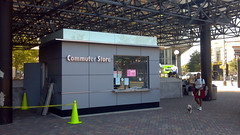 |
 |
 |
| The new Ballston commuter store. |
Arlington’s mobile commuter store |
Average Rating: 4.5 out of 5 based on 177 user reviews.
September 13th, 2011 | Permalink
Tags: development, galleries, transportation

I am what you might call a transit nerd. I get my kicks geeking out to new trains and new buses. All the cool kids are doing it, right? Anyway, for bus geekery specifically, the very best place in the DC region to observe a steady stream of diverse and cool buses is the corner of 7th and H Streets, at Gallery Place. Every Metrobus imaginable runs by there, plus the Circulator and a host of others. “Accordion buses” in particular, for which I am a giant sucker, are everywhere.
A few weeks ago I camped out at the corner with a pocket camera for maybe 10 minutes, and snapped these pictures. Enjoy.
Average Rating: 4.5 out of 5 based on 249 user reviews.
September 12th, 2011 | Permalink
Tags: bus, galleries, transportation

|
Media





Site
About BeyondDC
Archive 2003-06
Contact
Category Tags:
Partners
|
